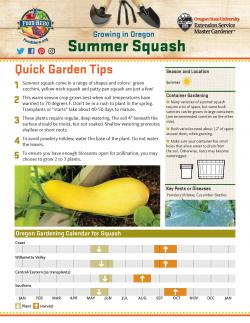Quick Garden Tips
- Summer squash come in a range of shapes and colors: green zucchini, yellow-neck squash and pattypan squash are just a few!
- This warm-season crop grows best when soil temperatures have warmed to 70 degrees F. Don’t be in a rush to plant in the spring. Transplants (“starts”) take about 40 to 50 days to mature.
- These plants require regular, deep watering. The soil 4" beneath the surface should be moist, but not soaked. Shallow watering promotes short roots.
- To avoid powdery mildew, water the base of the plant. Do not water the leaves.
- To ensure you have enough blossoms open for pollination, you may choose to grow 2 to 3 plants.
Season and Location
- Summer
Container Gardening
- Many varieties of summer squash require a lot of space, but some bush varieties can be grown in large containers (see recommended varieties on the other side).
- Bush varieties need about 12" of space around them.
- Make sure your container has small holes near the bottom to allow water to drain from the soil. Otherwise, roots may become waterlogged.
Key Pests and Diseases
- Powdery mildew, cucumber beetles
When to Plant and Harvest Squash in Oregon
- Coast: Plant seeds in May to harvest in late August through September.
- Western Valleys: Plant seeds in May through early June to harvest late August through September.
- Central and Eastern (as transplants): Plant seeds mid-May through early June to harvest mid-July through mid-August.
- Southern: Plant seeds in May to harvest early mid-September through mid-October.

Recommended Types to Grow
- Yellow Squash: Early Prolific, Straightneck, Fancycrook†, Gentry Goldbar†, Multipik, Superset, Sunray, Yellow Crookneck
- Patty Pan: Sunburst†
- Green Zucchini: Ambassador, Aristocrat, Cashflow, Elite, Floridor (round), Geode (round), Noche, Raven†, Seneca, Tigress
- Yellow Zucchini: Butterstick, Gold Rush
† These types can be grown in large containers.
How to Harvest
- For best taste, harvest while the skin is still tender (not tough) and smooth (not bumpy).
- Gently but firmly grab the squash near the end away from the plant. Lift up and twist to remove.
- Harvest often to encourage the plant to produce more squash.
- If you missed picking a squash and it grows large, remove it. This helps the plant put its energy into growing new squash.
Storage and Cooking
- You can remove the seeds of larger squash and add the raw, grated flesh to baked goods or pancakes. Or chop the squash and add it to soups.
- Try this Food Hero recipe: Lemony Garbanzo Bean Dip



